Autonomous driving is rapidly advancing from highway NOA to urban NOA, and poses ever higher technical requirements for high-precision positioning, highlighting the following:
1. Higher accuracy: urban lanes are changeable and traffic flow is complex. In particular, to achieve urban NOA in complex areas such as urban intersections, it needs centimeter-level high-precision positioning accuracy;
2. Introduction of PPP-RTK: PPP and RTK technologies are unified at the algorithm level for fast, real-time and high-precision positioning. Moreover, PPP-RTK can support both satellite broadcast and mobile communication modes, of which satellite broadcast can use low-orbit satellites;
3. Dual-frequency RTK is mainstream: in the industry there is a common belief that dual-frequency RTK has become mainstream after years of iteration, and it enables higher precision positioning, playing a critical role in the development of urban NOA technology;
4. Deep coupling algorithm is superior: compared with loose coupling and tight coupling technologies, deep coupling can effectively improve the accuracy and reliability of integrated navigation, especially in harsh environments like urban overpasses and roundabouts, and can greatly reduce positioning errors;
5. Introduction of low-orbit satellites: in urban scenarios where signals are often blocked by high-rise buildings and overpasses, the use of low-orbit satellites can enhance signal coverage and further improve reliability of satellite signals.
The application of low-orbit satellites in autonomous driving helps improve accuracy of high-precision positioning.
Low-orbit satellites offer some benefits in the fields of autonomous driving and even intelligent transportation and smart city. For example, in remote areas covered by unstable signals, they are a solution to the problem of insufficient positioning accuracy and real-time connection.
During the 19th Asian Games Hangzhou and the Hangzhou 4th Asian Para Games, Geespace used aerospace technology to support the Hangzhou Asian games, providing stable, safe, and uninterrupted satellite application services for nearly 2 months. On September 3, 2023, Geely delivered more than 2,000 officially designated vehicles to the Asian Games Organizing Committee. These vehicles are equipped with high-precision positioning products provided by Geespace, an arm of Geely. Relying on the high-precision positioning products and services, the location information of each of the vehicles is displayed in real time and accurately on the map of the Traffic Command Center of the Asian Games Organizing Committee, enabling precise management and scheduling of vehicles to ensure the mobility safety of the official designated vehicles for the Asian Games. In addition, some vehicles pack Geespace’s satellite communication terminals, further ensuring mobility safety.
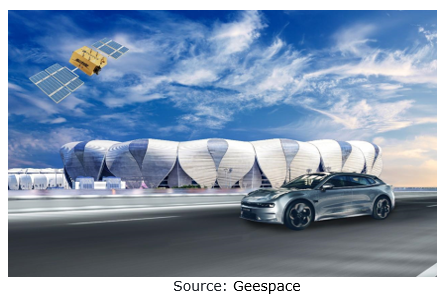
Geespace: it is a technology start-up under Geely Holding Group and China’s only private commercial aerospace company that has built a commercial closed loop. It has implemented vehicle satellite application products and services on large scale. In June 2022, it successfully launched the first nine self-developed “GeeSAT” satellites at one time.
Based on the self-developed low-orbit satellite system and constellation ground-based data station network, Geespace “GeeSAT” satellites build an intelligent space-time base, and make full use of the Beidou-3 system to provide industry-leading satellite-based high-precision positioning services and satellite communication services.
In the field of high-precision positioning, Geespace’s satellite-based high-precision positioning services have been largely available to vehicles for the first time in the world. On typical autonomous driving routes, Geespace’s satellite-based high-precision positioning services deliver positioning accuracy better than 10 centimeters (CEP95), higher than the industry level of 20 centimeters (CEP95), and up to the world’s leading level.
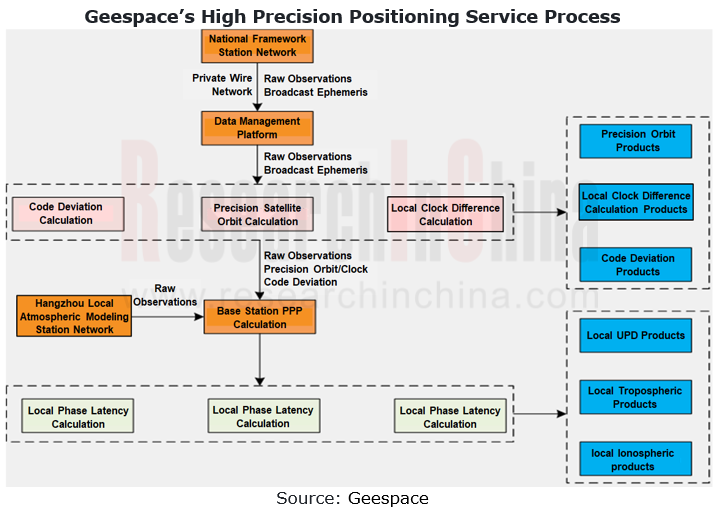
In the field of satellite communications, Geespace self-developed the world's first satellite communication terminal for production vehicles, Jishixun?, and has produced and used it in quantities. This terminal was first mounted on ZEEKR 001 FR, providing two-way satellite messaging and satellite call services. In addition, in terms of installation form in vehicles, Geespace has developed a high-throughput satellite Internet terminal featuring "vehicle-terminal" integrated design. The use of phased array technology allows it to be hidden into the existing shape of vehicles, without the antenna protruding. At present, Geespace’s satellite communication integrated vehicle glass antenna has also been tested, making the sunroof of vehicles turn into an antenna that integrates multiple communication capabilities in the future.
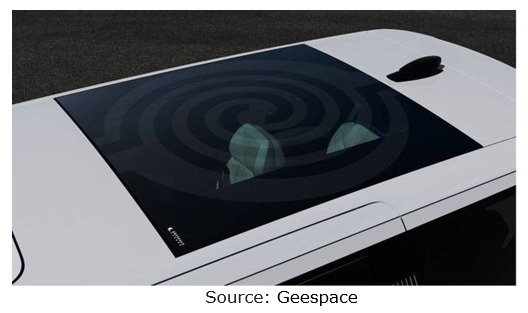
With the core technologies of GeeSAT and independent R&D capabilities, Geespace has built a full-stack software and hardware integrated product matrix covering data and algorithm services, chip-module-terminal products, and industry solutions, which are widely used in new energy vehicles, consumer electronics like drones, and public service fields. Geespace has built a complete R&D quality management system, achieved full-link management of software and hardware from requirements import to project filing, and then to technology R&D, test and acceptance, and mass production and delivery, expediting the creation of a commercial application closed loop.
P-box starts mass adoption in vehicles, and major suppliers scrabble for market share.
With regard to installation form of high-precision positioning in vehicles, currently GNSS and IMU are installed separately, integrated into an independent box (P-box), or directly attached into the domain controller. For P-box is calibrated before leaving factory, it features mature process and low cost. It is currently a cost-effective high-precision positioning option for automakers. It has now entered the phase of mass production and delivery. It is expected that for some time to come P-box will gradually become the mainstream installation form of high-precision positioning in vehicles.
In China, mainstream P-box suppliers such as Asensing and DAISCH have spawned P-box and installed it in vehicles. At present, Asensing prevails in the P-box market and its P-box has been widely used by Chinese independent auto brands:
Hyper GT, the flagship model of Hyper, a high-end luxury brand under GAC Aion, carries Asensing’s high-precision integrated positioning system, enabling centimeter-level high-precision global positioning;
"AD Max Intelligent Driving System" of Li Auto is equipped with P-Box, a high-precision integrated navigation and positioning system developed by Asensing;
Boyue L released by Geely packs P-Box, Asensing’s high-precision integrated positioning system;
NID3.0 advanced intelligent driving assistance system for Changan Deepal SL03 is equipped with P-Box, Asensing’s high-precision integrated positioning system.
As established P-box suppliers secure orders frequently, more players are attracted to enter the market.
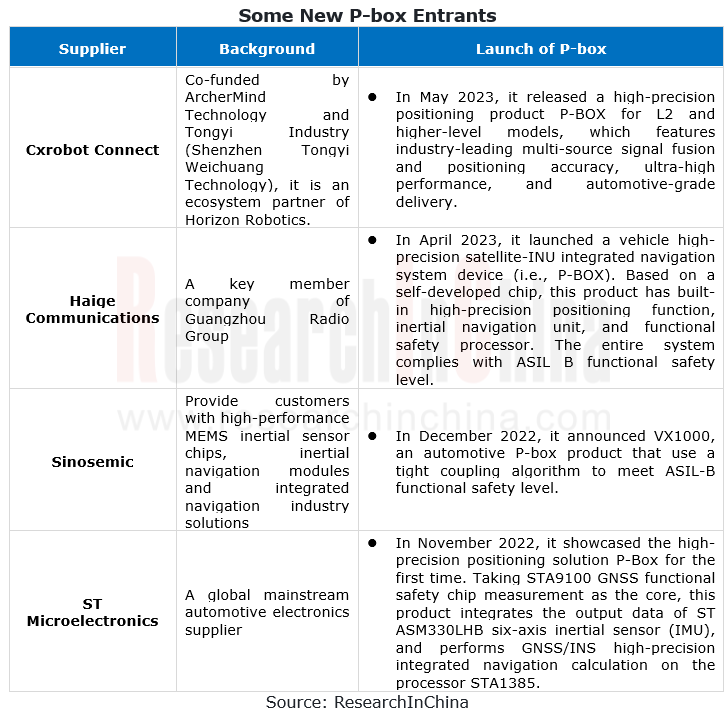
Cxrobot Connect: co-funded by ArcherMind Technology and Tongyi Industry (Shenzhen Tongyi Weichuang Technology), this company is an ecosystem partner of Horizon Robotics. In May 2023, it released a high-precision positioning product P-BOX for L2 and higher-level models, which features industry-leading multi-source signal fusion and positioning accuracy, ultra-high performance, and automotive-grade delivery.
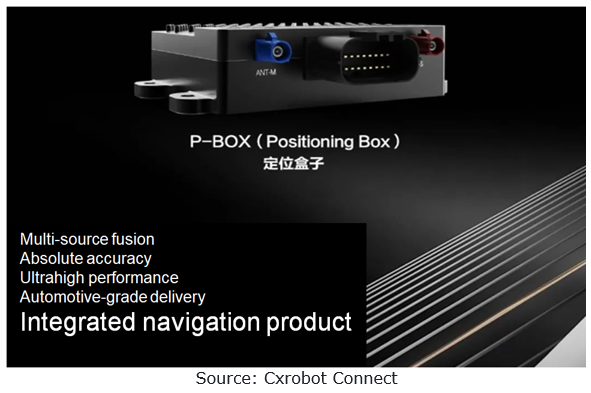
High-precision positioning solutions for next-generation electronic/electrical architecture
In the future, the centralization and integration of automotive E/E architecture will be a megatrend. While laying out P-box, some suppliers therefore are also working to develop products that integrate positioning modules into domain controllers.
In addition, OEMs also try hard to pursue lower vehicle hardware cost. The domain controller integration helps to lower the requirements for hardware and increase the complexity of algorithms, so as to ultimately achieve the goal of cost control.
In currant stage there are mainly several ways to integrate high-precision positioning hardware into domain controllers:
1. Integrate IMU separately into the domain control board;
2. Integrate GNSS and IMU separately into the domain control board;
3. Integrate the module composed of GNSS and IMU into the domain control board.
In April 2023, TuSimple launched TS-Box, a domain control centralized perception box that is designed according to commercial vehicle operating conditions, but supports both commercial vehicle and passenger car scenarios. It is expected to be mass-produced and delivered in 2024.
TuSimple TS-Box integrates TuSimple's self-developed autonomous driving domain controller, 4D radar solution, centralized RTK-GNSS/INS positioning module, and perception and positioning fusion algorithms. Compared with purchasing each component separately, TS-Box can cut down the overall cost by about 25%.
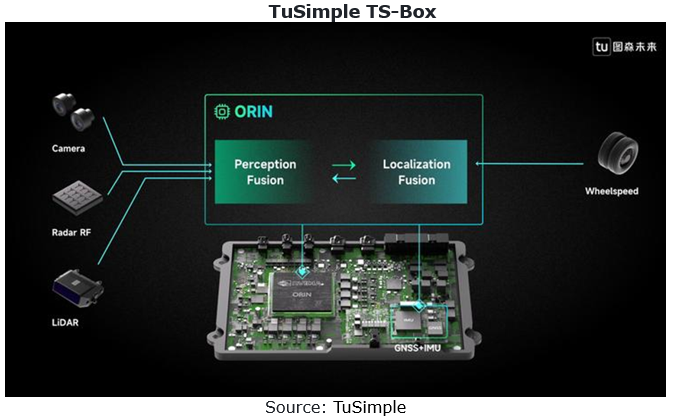
High Precision Positioning Industry Report, 2023-2024 highlights the following:
 Autonomous driving high-precision positioning industry (policies & standards, market size, market pattern, etc.);
Autonomous driving high-precision positioning industry (policies & standards, market size, market pattern, etc.);
 Main autonomous driving high-precision positioning technologies (GNSS, IMU, GNSS+IMU integrated positioning, etc.) (supplier pattern, technology trends, etc.)
Main autonomous driving high-precision positioning technologies (GNSS, IMU, GNSS+IMU integrated positioning, etc.) (supplier pattern, technology trends, etc.)
 The main development trends of autonomous driving high-precision positioning technologies (fusion algorithm, PPP-RTK, low-orbit satellite, etc.);
The main development trends of autonomous driving high-precision positioning technologies (fusion algorithm, PPP-RTK, low-orbit satellite, etc.);
 Autonomous driving high-precision positioning in vehicles (new integration modes, installation by OEMs, installation scale, etc.);
Autonomous driving high-precision positioning in vehicles (new integration modes, installation by OEMs, installation scale, etc.);
 Classification of main application scenarios of high-precision positioning in autonomous driving (highway NOA, urban NOA, AVP, autonomous delivery, autonomous trucks, etc.);
Classification of main application scenarios of high-precision positioning in autonomous driving (highway NOA, urban NOA, AVP, autonomous delivery, autonomous trucks, etc.);
 High-precision positioning basic service companies (technology layout, developments, etc.);
High-precision positioning basic service companies (technology layout, developments, etc.);
 High-precision positioning module suppliers (profile, product layout, technology status, product application, etc.).
High-precision positioning module suppliers (profile, product layout, technology status, product application, etc.).
Research Report on Overseas Layout of Chinese Passenger Car OEMs and Supply Chain Companies, 2024
Research on overseas layout of OEMs: There are sharp differences among regions. The average unit price of exports to Europe is 3.7 times that to Southeast Asia.
The Research Report on Overseas Layou...
In-vehicle Payment and ETC Market Research Report, 2024
Research on in-vehicle payment and ETC: analysis on three major application scenarios of in-vehicle payment
In-vehicle payment refers to users selecting and purchasing goods or services in the car an...
Automotive Audio System Industry Report, 2024
Automotive audio systems in 2024: intensified stacking, and involution on number of hardware and software tuning
Sales of vehicle models equipped with more than 8 speakers have made stea...
China Passenger Car Highway & Urban NOA (Navigate on Autopilot) Research Report, 2024
NOA industry research: seven trends in the development of passenger car NOA
In recent years, the development path of autonomous driving technology has gradually become clear, and the industry is acce...
Automotive Cloud Service Platform Industry Report, 2024
Automotive cloud services: AI foundation model and NOA expand cloud demand, deep integration of cloud platform tool chainIn 2024, as the penetration rate of intelligent connected vehicles continues to...
OEMs’ Passenger Car Model Planning Research Report, 2024-2025
Model Planning Research in 2025: SUVs dominate the new lineup, and hybrid technology becomes the new focus of OEMs
OEMs’ Passenger Car Model Planning Research Report, 2024-2025 focuses on the medium ...
Passenger Car Intelligent Chassis Controller and Chassis Domain Controller Research Report, 2024
Chassis controller research: More advanced chassis functions are available in cars, dozens of financing cases occur in one year, and chassis intelligence has a bright future. The report combs th...
New Energy Vehicle Thermal Management System Market Research Report, 2024
xEV thermal management research: develop towards multi-port valve + heat pump + liquid cooling integrated thermal management systems.
The thermal management system of new energy vehicles evolves fro...
New Energy Vehicle Electric Drive and Power Domain industry Report, 2024
OEMs lead the integrated development of "3 + 3 + X platform", and the self-production rate continues to increase
The electric drive system is developing around technical directions of high integratio...
Global and China Automotive Smart Glass Research Report, 2024
Research on automotive smart glass: How does glass intelligence evolve
ResearchInChina has released the Automotive Smart Glass Research Report 2024. The report details the latest advances in di...
Passenger Car Brake-by-Wire and AEB Market Research Report, 2024
1. EHB penetration rate exceeded 40% in 2024H1 and is expected to overshoot 50% within the yearIn 2024H1, the installations of electro-hydraulic brake (EHB) approached 4 million units, a year-on-year ...
Autonomous Driving Data Closed Loop Research Report, 2024
Data closed loop research: as intelligent driving evolves from data-driven to cognition-driven, what changes are needed for data loop?
As software 2.0 and end-to-end technology are introduced into a...
Research Report on Intelligent Vehicle E/E Architectures (EEA) and Their Impact on Supply Chain in 2024
E/E Architecture (EEA) research: Advanced EEAs have become a cost-reducing tool and brought about deep reconstruction of the supply chain
The central/quasi-central + zonal architecture has become a w...
Automotive Digital Power Supply and Chip Industry Report, 2024
Research on automotive digital power supply: looking at the digital evolution of automotive power supply from the power supply side, power distribution side, and power consumption side
This report fo...
Automotive Software Business Models and Suppliers’ Layout Research Report, 2024
Software business model research: from "custom development" to "IP/platformization", software enters the cost reduction cycle
According to the vehicle software system architecture, this report classi...
Passenger Car Intelligent Steering Industry Research Report, 2024
Intelligent Steering Research: Steer-by-wire is expected to land on independent brand models in 2025
The Passenger Car Intelligent Steering Industry Research Report, 2024 released by ResearchInChina ...
China Passenger Car Mobile Phone Wireless Charging Research Report, 2024
China Passenger Car Mobile Phone Wireless Charging Research Report, 2024 highlights the following:Passenger car wireless charging (principle, standards, and Qi2.0 protocol);Passenger car mobile phone ...
Automotive Smart Exteriors Research Report, 2024
Research on automotive smart exteriors: in the trend towards electrification and intelligence, which exteriors will be replaced by intelligence
The Automotive Smart Exteriors Research Report, 2024 r...